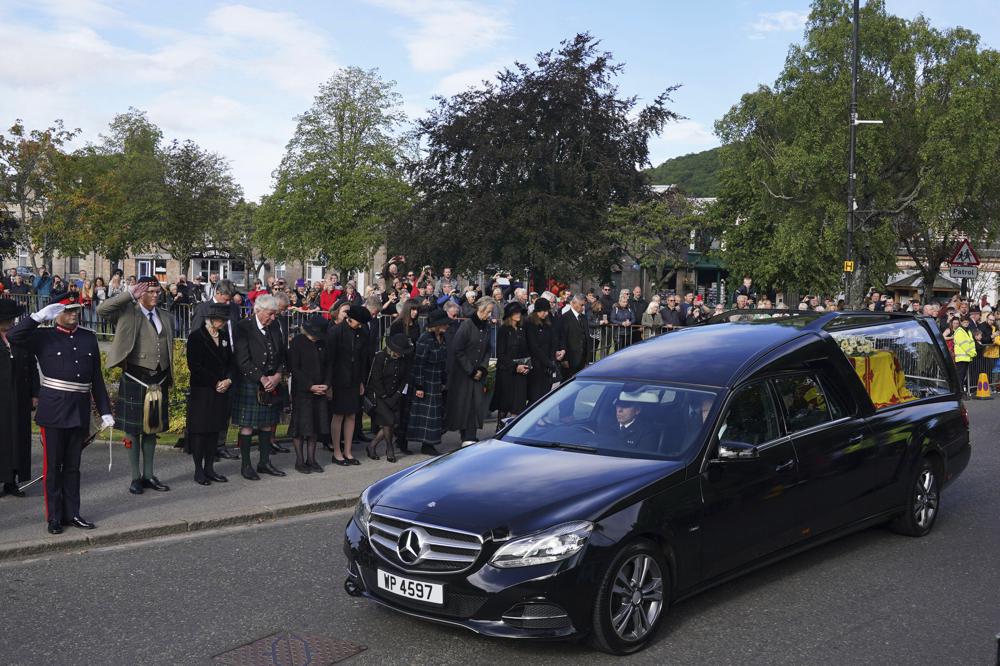Members of the public line the streets in Ballater, Scotland, as the hearse carrying the coffin of Queen Elizabeth II passes through as it makes its journey to Edinburgh from Balmoral in Scotland, Sunday, Sept. 11, 2022. The Queen’s coffin will be transported Sunday on a journey from Balmoral to the Palace of Holyroodhouse in Edinburgh, where it will lie at rest before being moved to London later in the week. (Andrew Milligan/PA via AP)
LONDON (AP) — Queen Elizabeth II’s flag-draped coffin is passing through the rugged Scottish countryside Sunday on a final journey from her beloved summer estate Balmoral Castle to London, with mourners quietly lining roads and some tossing flowers to honor the monarch who died after 70 years on the throne.
The hearse drove past piles of bouquets and other tributes as it led a seven-car cortege from Balmoral, where the queen died Thursday, for a six-hour trip through Scottish towns to Holyroodhouse palace in Edinburgh. The late queen’s coffin was draped in the Royal Standard for Scotland and topped with a wreath made of flowers from the estate, including sweet peas, one of the queen’s favorites.
“A sad and poignant moment as Her Majesty, The Queen leaves her beloved Balmoral for the final time,” the first minister of Scotland, Nicola Sturgeon tweeted. “Today, as she makes her journey to Edinburgh, Scotland will pay tribute to an extraordinary woman.”
Crowds lined parts of the route as the nation mourns its longest-reigning monarch, the only one most Britons have ever known. In the Scottish village of Ballater, where residents regard the royal family as neighbors, hundreds of people watched in silence and some threw flowers in front of the hearse as it passed.
“She meant such a lot to people in this area. People were crying, it was amazing to see,” said Victoria Pacheco, a guest house manager.
In each town and village the cars drove through, they were met with similar muted scenes of respect. People stood mostly in silence; some clapped politely, others pointed their phone cameras at the passing cars.
Before reaching the Scottish capital, the cortege is traveling down what is effectively a royal memory lane — passing through locations laden with House of Windsor history including Dyce, where in 1975 the queen formally opened the U.K.’s first North Sea oil pipeline, and Fife near St. Andrews University, where her grandson William, now the Prince of Wales, studied and met his future wife, Catherine.
Sunday’s solemn drive through Scotland came as the queen’s eldest son was formally proclaimed the new monarch — King Charles III — in the rest of the nations of the United Kingdom: Scotland, Wales and Northern Ireland. It came a day after a pomp-filled accession ceremony in England steeped in ancient tradition and political symbolism.
“I am deeply aware of this great inheritance and of the duties and heavy responsibilities of sovereignty, which have now passed to me,” Charles said Saturday.
Just before the proclamation was read Sunday in Edinburgh, a protester appeared with a sign condemning imperialism and urging leaders to “abolish the monarchy,” getting taken away soon afterward by police. The crowd applauded.
One man shouted, “Let her go! It’s free speech!” while others shouted: “Have some respect.”
It’s a sign of how some, including the former British Empire colonies, are struggling with the legacy of the monarchy. Earlier, proclamations were read in other parts of the Commonwealth countries, including Australia and New Zealand.
Charles, even as he mourned his late mother, was getting to work at Buckingham Palace, meeting with the secretary-general and other representatives of the Commonwealth, nations grappling with affection for the queen and lingering bitterness over their colonial legacies, ranging from slavery to corporal punishment in African schools to looted artifacts held in British institutions.
Australian Prime Minister Anthony Albanese, who had started laying the groundwork for an Australian republic after elections in May, said Sunday that now was the time not for a change but for paying tribute to the late queen.
India, a former British colony, observed a day of state mourning, with flags lowered to half-staff on all government buildings throughout the country.
Amid the grief enveloping the House of Windsor, there were hints of a possible family reconciliation. Prince William and his brother Harry, together with their respective wives, Catherine, Princess of Wales, and Meghan, Duchess of Sussex, delighted mourners near Windsor Castle with a surprise joint appearance Saturday.
The queen’s coffin will take a circuitous journey back to the capital. On Monday, it will be taken from Holyroodhouse to nearby St. Giles’ Cathedral, where it will remain until Tuesday, when it will be flown to London. The coffin will be moved from Buckingham Palace on Wednesday to the Houses of Parliament to lie in state until a state funeral at Westminster Abbey on Sept. 19.
In Ballater, the Rev. David Barr said locals consider the royals as “neighbors” and try to treat them as locals when they spend summers in the Scottish Highlands.
“When she comes up here, and she goes through those gates, I believe the royal part of her stays mostly outside,” he said. “And as she goes in, she was able to be a wife, a loving wife, a loving mum, a loving gran and then later on a loving great-gran — and aunty — and be normal.”
Elizabeth Taylor, from Aberdeen, had tears in her eyes after the hearse carrying the queen’s coffin passed through Ballater.
“It was very emotional. It was respectful and showed what they think of the queen,” she said. “She certainly gave service to this country even up until a few days before her death.”
Copyright 2021 Associated Press. All rights reserved.


































